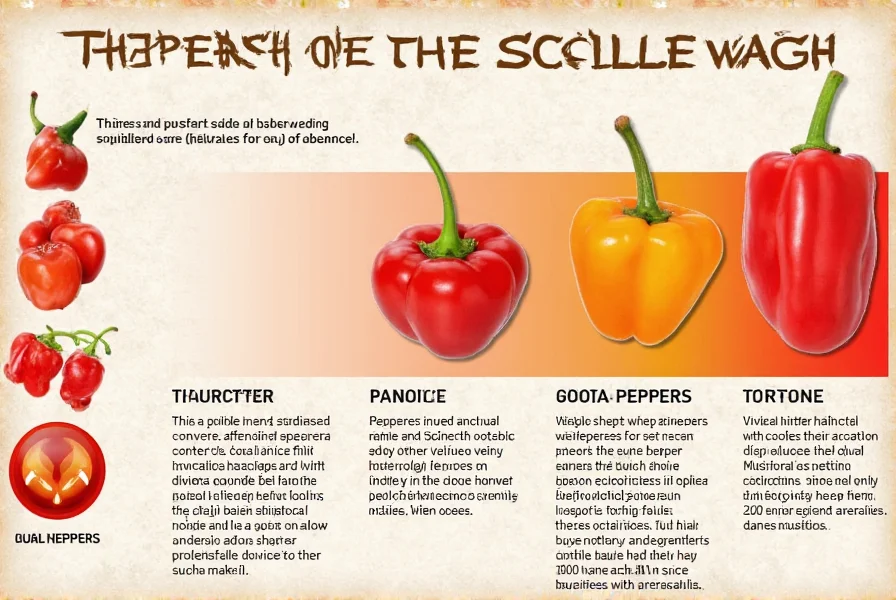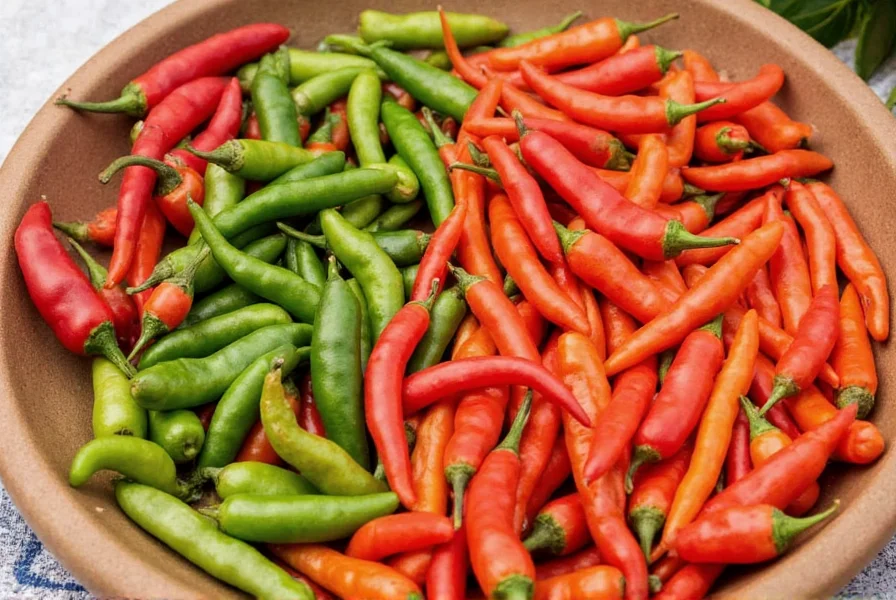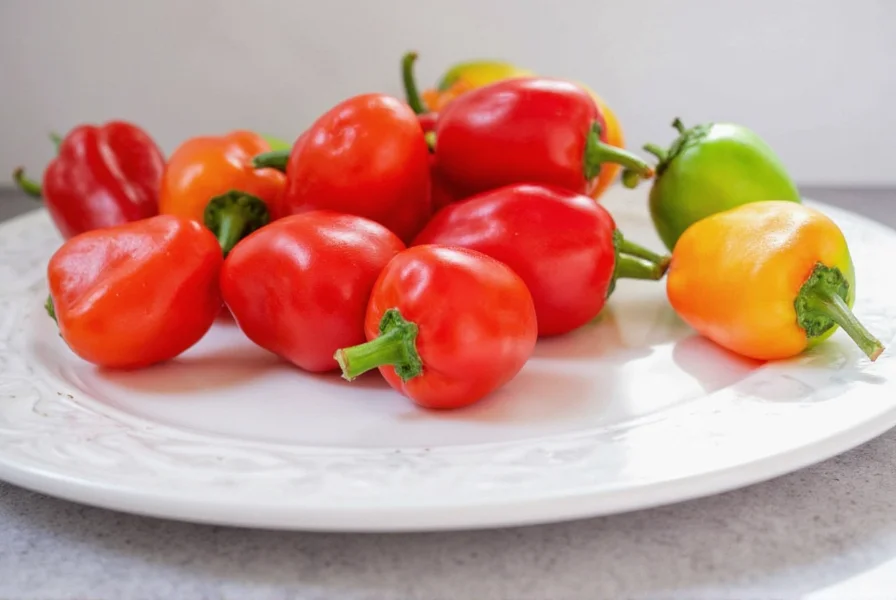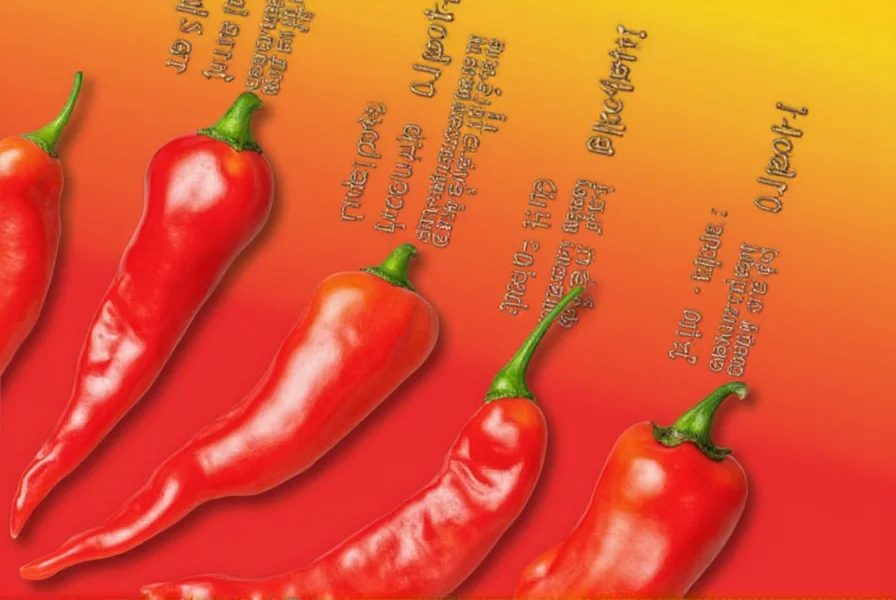| Pepper Type | Scoville Heat Units (SHU) |
|---|---|
| Bell Pepper | 0 SHU |
| Poblano | 1,000–2,000 SHU |
| Jalapeño | 2,500–8,000 SHU |
| Serrano | 10,000–23,000 SHU |
| Cayenne | 30,000–50,000 SHU |
| Habanero | 100,000–350,000 SHU |
| Ghost Pepper (Bhut Jolokia) | 855,000–1,041,427 SHU |
| Trinidad Moruga Scorpion | 1,200,000–2,000,000 SHU |
| Carolina Reaper | 1,400,000–2,200,000 SHU |
| Pepper X | 2,693,000–3,180,000 SHU |










1. Introduction to Peppers by Spiciness
Understanding pepper heat levels is essential for any culinary adventure. Whether you're a novice cook or a seasoned spice lover, knowing how to navigate the Scoville scale ensures you select the perfect pepper for your dish without overwhelming your taste buds.
2. Understanding the Scoville Scale
The Scoville scale measures capsaicin concentration in chili peppers, determining their heat intensity. Developed in 1912 by Wilbur Scoville, modern testing uses high-performance liquid chromatography for precise measurement. Here's a comprehensive reference:
3. Top 10 Hottest Peppers in the World (2025)
- Pepper X (2.69M–3.18M SHU): Created by Ed Currie, this record-breaking pepper surpasses the Carolina Reaper in heat. Used sparingly in specialty hot sauces.
- Carolina Reaper (1.4M–2.2M SHU): Former world's hottest pepper, known for its fruity flavor and intense heat. Commonly used in competitive eating challenges.
- Dragon's Breath (2.48M SHU): Developed in Wales, this pepper requires extreme caution during handling due to its high capsaicin levels.
- Trinidad Moruga Scorpion (1.2M–2M SHU): Sweet aroma with intense heat. Popular in Caribbean cuisine for sauces and marinades.
- Ghost Pepper (Bhut Jolokia) (855K–1.04M SHU): Originated in Northeast India, used in traditional dishes and hot sauces.
- Naga Viper (1.3M SHU): Crossbreed of Ghost Pepper, Naga Jolokia, and Trinidad Scorpion. Known for its extreme heat and complex flavor profile.
- 7 Pot Douglah (1M–1.5M SHU): Dark brown pepper with rich chocolate notes. Used in Trinidadian cooking and specialty hot sauces.
- 7 Pot Primo (1M SHU): Similar to 7 Pot Douglah but slightly milder. Often used in Caribbean jerk seasoning.
- Komodo Dragon (1.4M SHU): A hybrid pepper with intense heat and smoky flavor. Rarely available outside specialty markets.
- Scorpion Butch T (1.2M–1.5M SHU): Named after the late Butch Taylor, this pepper is a staple in competitive eating circuits.
4. Practical Tips for Handling and Cooking with Spicy Peppers
- Always wear nitrile gloves when handling peppers above 100,000 SHU. Capsaicin can cause severe skin irritation and eye damage.
- Remove seeds and membranes for controlled heat. These contain 80% of the capsaicin concentration.
- Use acid-based ingredients like lime juice or vinegar to neutralize heat. Dairy products like yogurt or milk are more effective for existing burns.
- Start with small quantities when cooking. A single drop of pepper extract can make a dish inedible.
5. Buying Guide: How to Choose the Right Pepper
- For beginners: Start with jalapeños (2.5K–8K SHU) or poblanos (1K–2K SHU). Ideal for salsas, tacos, and stuffed peppers.
- Intermediate heat seekers: Try cayenne (30K–50K SHU) or serrano (10K–23K SHU) for authentic Mexican dishes and hot sauces.
- Advanced enthusiasts: Habaneros (100K–350K SHU) or ghost peppers (855K–1M SHU) for complex flavor profiles in Caribbean and Indian cuisine.
- Extreme heat challenges: Only use Carolina Reaper or Pepper X in controlled environments. Always have dairy products on hand to mitigate burns.
6. Frequently Asked Questions
- What is the current world's hottest pepper as of 2025?
- Pepper X holds the official title with 2.69M–3.18M SHU, verified by the Guinness World Records in 2023. It's significantly hotter than the Carolina Reaper.
- How can I safely handle super-hot peppers?
- Always wear nitrile gloves, avoid touching your face, and work in a well-ventilated area. If contact occurs, wash immediately with soap and water. For eye exposure, flush with saline solution and seek medical attention.
- Are there any health risks with consuming extremely hot peppers?
- Yes. Consuming peppers above 1M SHU can cause gastrointestinal distress, temporary loss of taste, and in rare cases, hospitalization. Always consult a doctor before attempting extreme heat challenges.
- Why do some peppers have different heat levels in different regions?
- Climate, soil conditions, and growing methods affect capsaicin production. A Carolina Reaper grown in South Carolina may be 30% hotter than one grown in Florida due to temperature variations.
- How do I store fresh hot peppers?
- Store in a paper bag in the refrigerator for up to 2 weeks. For long-term storage, freeze whole peppers or dry them using a food dehydrator. Never store in plastic bags as moisture accelerates spoilage.
- Can I grow super-hot peppers at home?
- Yes, but they require specific conditions: 8–10 hours of direct sunlight, consistent 75–90°F temperatures, and well-draining soil. Start seeds indoors 8–10 weeks before last frost. Wear gloves during all handling stages.
7. Conclusion
Understanding pepper heat levels transforms your cooking from risky to rewarding. Always verify pepper varieties through reputable sources like the Guinness World Records or USDA databases. When in doubt, start with milder peppers and gradually increase heat intensity. Remember: the goal is enjoyment, not endurance.










 浙公网安备
33010002000092号
浙公网安备
33010002000092号 浙B2-20120091-4
浙B2-20120091-4